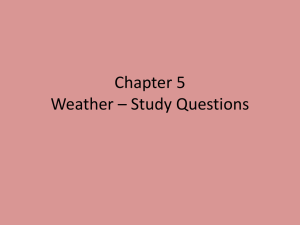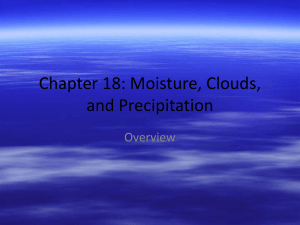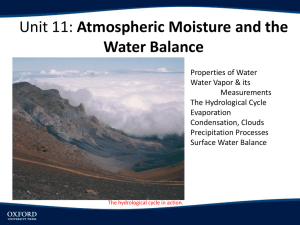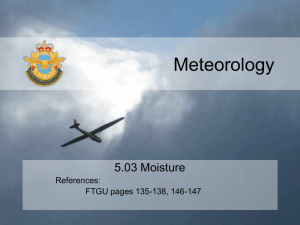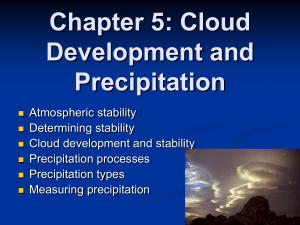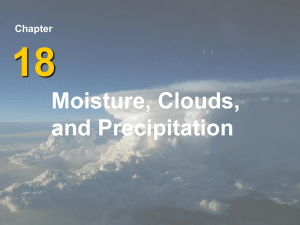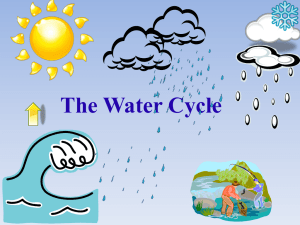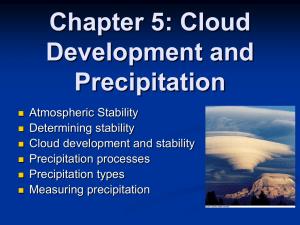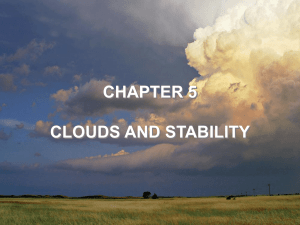Chapter 4
advertisement
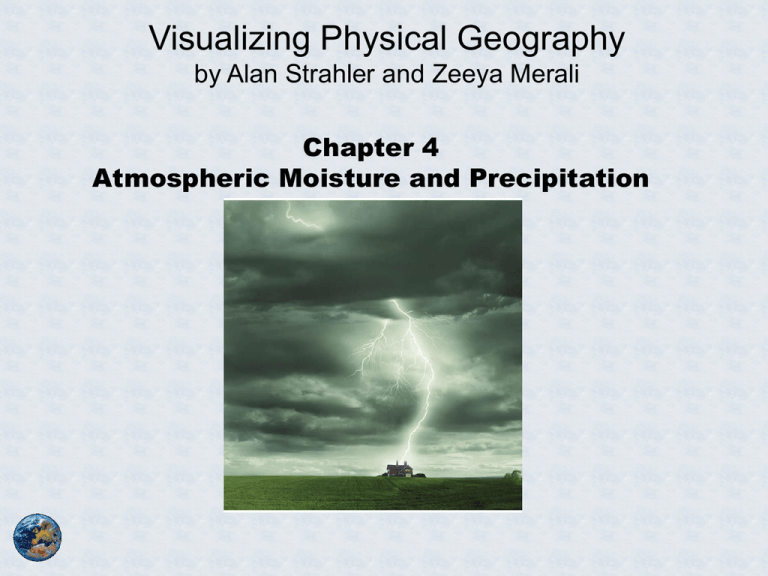
Visualizing Physical Geography by Alan Strahler and Zeeya Merali Chapter 4 Atmospheric Moisture and Precipitation Water and the Hydrosphere Three States of Water: •Solid (ice) •Liquid (water) •Gas (vapor) Water and the Hydrosphere Distribution of water in the hydrosphere Precipitation: Particles of liquid water or ice that fall from the atmosphere and may reach the ground. Humidity Humidity: the amount of water vapor in the air Humidity Relative Humidity: compares the amount of water vapor present in the air to the maximum amount that the air can hold at that temperature Humidity Relative Humidity changes when: 1. Atmosphere gains or loses water vapor • Evaporation 2. Temperature changes • Lower temperature relative humidity rises • Raise temperature relative humidity decreases Specific Humidity: actual quantity of water held by a parcel of air • Grams of water vapor per kilogram of air (g/kg) Humidity Dew-point temperature: temperature at which air with a given humidity will reach saturation when cooled without changing its pressure The Adiabatic Process Adiabatic Principle: the physical principle that a gas cools as it expands and warms as it is compressed Change in temperature: • caused only by a change in pressure • not caused by heat flowing in or out of the gas The Adiabatic Process Atmospheric pressure decreases with altitude so... As a parcel of air rises pressure on the parcel decreases air expands and cools As a parcel of air descends pressure on the parcel increases air is compressed and warms Dry adiabatic lapse rate Wet adiabatic lapse rate Clouds Clouds consist of water droplets, ice crystals, or both Condensation nucleus? Cloud Families: High clouds, middle clouds, low clouds, clouds of vertical development Clouds Cumulus Clouds Cumuliform clouds: globular masses of cloud, associated with parcels of rising air Clouds Stratus Clouds Image ID: wea02050, NOAA's National Weather Service (NWS) Collection Photographer: Ralph F. Kresge http://www.photolib.noaa.gov/htmls/wea02050.htm Stratiform clouds: blanket-like, cover large areas Clouds Cirrus Clouds Cirrus clouds: high, thin, wispy clouds composed of ice crystals Clouds Fog is a cloud layer at or close to Earth’s surface • Radiation fog: formed when temperature of the air at ground level falls below dew point • Advection fog: forms when warm moist air moves over a cold surface •Common over oceans (“sea fog”) Image ID: wea03250, NOAA's National Weather Service (NWS) Collection Photographer: LCDR Mark Wetzler, NOAA Corps http://www.photolib.noaa.gov/htmls/wea03250.htm Precipitation • Rain • Snow • Hail • Ice storm Rain formation in warm clouds Precipitation To form precipitation, air must move upward and chill by adiabatic processes. Four ways for air to move upward: 1.Orographic precipitation 2.Convectional precipitation 3.Cyclonic precipitation 4.Convergence Rain shadow: a belt of dry climate that extends down and beyond the leeward slope of a mountain range Precipitation Convectional precipitation: precipitation induced when warm, moist air is heated at the ground surface, rises, cools, and condenses to form water droplets, raindrops, and rainfall Lifting condensation level: level at which condensation begins Precipitation Thunderstorm: intense local storm associated with a tall, dense cumulonimbus cloud in which there are very strong updrafts of air Conditions: 1.Warm, moist air 2.An environmental lapse rate in which temperature decreases more rapidly with altitude than it does for either the dry or wet adiabatic lapse rates Precipitation Thunderstorm Cell Hailstorm Frequency Air Quality Air pollutant: an unwanted substance injected into the atmosphere from the Earth’s surface by either natural or human activities. Includes: • Aerosols • Gases • Particulates Smog? Air Quality Acid deposition: sulfur dioxide (SO2) and nitric oxide (NO2) released into the air combines with water to form sulfuric and nitric acids. Acidity of rainwater in U.S., 2005 Air Quality Effects of acid rain? Solutions?
